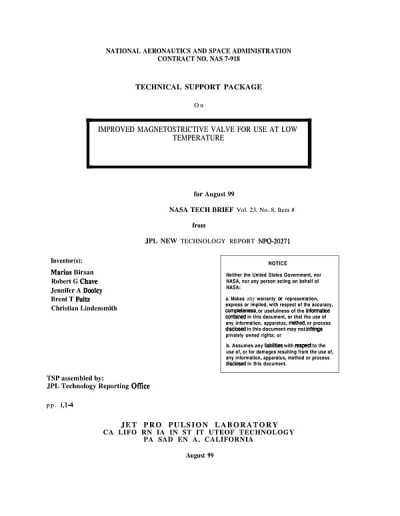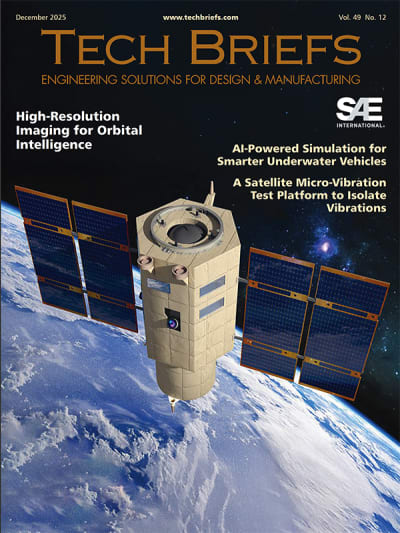An improved magnetostrictive valve for remotely controlling a flow of liquid helium has been developed. Heretofore, flows of liquid helium have been controlled by use of valves with mechanical or gas connections to actuators in warmer locations. The connections act as heat-leak paths. In contrast, the design of the present valve is optimized for operation at liquid-helium temperature (below 4.2 K), so that the entire valve can be maintained at or slightly above liquid-helium temperature to minimize leakage of heat into the liquid helium.

A valve with some similarities to the present one was described in "Magnetostrictive Valve for Use at Low Temperature" (NPO-19480), NASA Tech Briefs, Vol. 21, No. 2 (February 1997), page 14b. The poppet in this valve, as in the previous one, is a ball contained in a passage between an inlet and an outlet. In this case, the ball is made of 440C and is of high sphericity [root-mean-square deviation< 5 µin. (0.127 µm)]. The valve seat is made of superclean, fine-grained 316L steel and is initially lapped to optical flatness. In a later stage of fabrication, the ball is used to "coin" the seat.
As in the previous valve, the actuator in this valve is a magnetostrictive device comprising a rod of terbium/dysprosium alloy surrounded by a solenoidal drive coil that generates the magnetic field needed for actuation. The Tb/Dy alloy was chosen because it exhibits a large magnetostriction in the intended cryogenic operational temperature range. The Tb/Dy rod is mounted in such a way as to provide for removal and installation of different drive coils. To minimize generation of heat in the cryogenic environment, a superconductive drive coil can be used. For temperatures up to 77 K, one can use high-temperature superconductor; for liquid-helium temperature, one can use a superconductive Nb/Ti alloy.
Stainless filters containing submicron pores are inserted in the inlet and outlet ports of the valve to prevent particulate contamination and thereby prolong the operational life of the valve. The "dead" volume in this valve is only 6 µL on the outlet side. In tests at a temperature of 77 K, the valve withstood 300 actuations, with no sign of helium leakage. The valve was also tested at 4.2 K for several actuations with no sign of helium leakage.
This work was done by Robert Chave, Christian Lindensmith, Jennifer Dooley, Brent Fultz, and Marius Birsan of Caltech for NASA's Jet Propulsion Laboratory.
In accordance with Public Law 96-517, the contractor has elected to retain title to this invention. Inquiries concerning rights for its commercial use should be addressed to
Technology Reporting Office
JPL
Mail Stop 122-116
4800 Oak Grove Drive
Pasadena, CA 91109
(818) 354-2240
Refer to NPO-20271
This Brief includes a Technical Support Package (TSP).

Improved magnetostrictive valve for use at low temperature
(reference NPO20271) is currently available for download from the TSP library.
Don't have an account?
Overview
The document details the development of an improved magnetostrictive valve designed for controlling the flow of liquid helium at cryogenic temperatures, specifically below 4.2 K. This valve addresses several challenges associated with traditional liquid helium valves, which often suffer from limited cycle life, self-contamination, significant heat leakage, and large dead volumes.
Key innovations in this valve include the use of a magnetostrictive actuator made from a terbium/dysprosium alloy, which exhibits significant magnetostriction at cryogenic temperatures. This actuator is surrounded by a solenoidal drive coil that can be a high-temperature superconductor for temperatures up to 77 K or a superconductive niobium/titanium alloy for liquid helium temperatures. The design minimizes heat leakage by maintaining the entire valve at or slightly above liquid helium temperature, thus reducing the potential for heat transfer into the liquid helium.
The valve features a ball poppet made of 440C steel, known for its high sphericity, which is crucial for ensuring a tight seal. The valve seat is crafted from superclean, fine-grained 316L steel, initially lapped to optical flatness, and then "coined" with the ball to achieve a highly uniform surface. This meticulous fabrication process enhances the valve's performance and longevity.
Additionally, the valve incorporates porous filters at both the inlet and outlet ports to prevent particulate contamination, further extending the operational life of the valve. The design also allows for the use of different types of solenoids, enabling flexibility in field generation across various temperature ranges and cost considerations.
Testing has demonstrated the valve's robustness, with successful operation at 77 K and 4.2 K, showing no signs of helium leakage after multiple actuations. The document highlights the collaborative efforts of a team from Caltech and NASA's Jet Propulsion Laboratory, emphasizing the valve's potential applications in cryogenic systems.
Overall, this improved magnetostrictive valve represents a significant advancement in cryogenic technology, offering enhanced reliability, reduced contamination, and improved efficiency for applications involving liquid helium.

